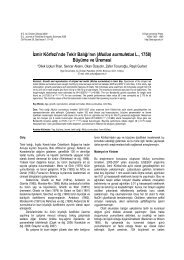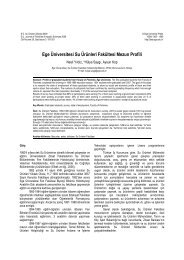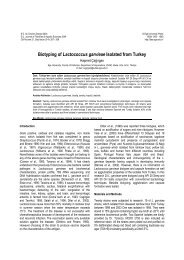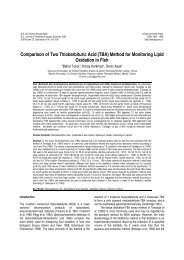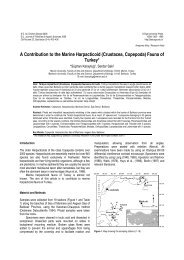Sepia officinalis - Journal of Fisheries and Aquatic Sciences
Sepia officinalis - Journal of Fisheries and Aquatic Sciences
Sepia officinalis - Journal of Fisheries and Aquatic Sciences
Create successful ePaper yourself
Turn your PDF publications into a flip-book with our unique Google optimized e-Paper software.
72<br />
Ünlüsayın et al., Ege J Fish Aqua Sci 28(3): 71-74 (2011)<br />
larger importance in the future to supply mankind with marine<br />
living resources (Piatowski et al., 2001). Total cephalopod<br />
l<strong>and</strong>ings were increased steadily since 1950s (FAO, 2005).<br />
The aim <strong>of</strong> the preset study was to determine the effects<br />
<strong>of</strong> salting on cuttlefish flesh as a preprocessing before smoked<br />
<strong>and</strong> also the protein loss <strong>of</strong> species with different salting<br />
methods. Determination <strong>of</strong> the best salting method as a<br />
preliminary application for processing was crucial to avoid<br />
nutrient loss.<br />
Materials <strong>and</strong> Methods<br />
Common cuttlefish (<strong>Sepia</strong> <strong><strong>of</strong>ficinalis</strong> L., 1758) was used for<br />
this investigation. Cuttlefish were gillnetted with local<br />
fisherman from Boğazkent, (Serik-Antalya, Turkey) in April-<br />
2007. Mean total body mass <strong>and</strong> mantle length <strong>of</strong> individuals<br />
were 98.6±17.7 g <strong>and</strong> 9.2±0.5 cm, respectively. Samples<br />
were then transported to laboratory in polystyrene boxes in<br />
crushed ice during approximately 60 min. Totally, for<br />
treatments <strong>of</strong> 30 common cuttlefish each were used for 4<br />
different treatments.<br />
The viscera, head <strong>and</strong> arms <strong>of</strong> the cuttlefishes were<br />
removed <strong>and</strong> mantles were washed with water. Salt, also<br />
known as rock salt, is a crystalline mineral that is composed<br />
primarily <strong>of</strong> sodium chloride (NaCl) <strong>and</strong> that used for salting<br />
process was purchased from local market (Antalya). The salt<br />
processes (salt concentration, ratio <strong>of</strong> cuttlefish to brine) were<br />
chosen based on seafood industrial practices <strong>of</strong> the firms<br />
(Antalya-Turkey) as follows. Brine salting <strong>and</strong> dry salting<br />
processes were conducted in plastic containers at 4±1ºC. The<br />
concentrations <strong>of</strong> salt in brine solutions were 8% (R) <strong>and</strong> 20%<br />
(W) (w/w), <strong>and</strong> curing processes using these brine<br />
concentrations with a fish to brine ratio <strong>of</strong> 1:1 were carried out<br />
for a period <strong>of</strong> 6 h <strong>and</strong> 45 min respectively. Dry salting (D) was<br />
run for 12 h <strong>and</strong> salting process was carried by covering the<br />
surface <strong>of</strong> fish. Thereby squid was inserted into a salt layer.<br />
After the curing process salted mantles <strong>of</strong> the cuttlefishes<br />
were then used for the analysis. Unsalted fish were used as<br />
control. pH was measured in the dorsal muscle with a digital<br />
electronic pH meter with a glass electrode (WTW Mark, 320,<br />
Germany).<br />
The chemical contents <strong>of</strong> common cuttlefish flesh <strong>and</strong><br />
extract were determined according to Official Methods <strong>of</strong><br />
Analysis. Moisture contents were in fish flesh determined<br />
according to method 950.46 (AOAC, 2002a). Crude protein<br />
content (Nx6.25) was calculated using the Kjeldahl method<br />
(AOAC, 2002b). Lipid (fat) content was determined according<br />
to Soxhlet method (AOAC, 2002c). Crude ash (Inorganic<br />
matter in meat) was determined according to method 920.153<br />
(AOAC, 2002d). Sodium chloride was determined by<br />
volumetric method (AOAC, 1995). Solid matter in extract was<br />
determined according to Gravimetric method 952.08 (AOAC,<br />
2002a). After the water in extract was removed, crude ash in<br />
extract was calculated according to method Official Methods<br />
<strong>of</strong> Analysis (AOAC, 2002d) <strong>and</strong> the organic matter in extract<br />
was calculated by using the following formula:<br />
Organic matter in extract (%) = 100 – Crude ash in extract.<br />
A total <strong>of</strong> 1.5 g minced muscle tissue <strong>of</strong> cuttlefish were<br />
homogenised at 4°C for 1 min in 9.5 ml physiological saline<br />
(0.9% NaCl) with a mechanical homogenizer (Heidolph, Slient<br />
Crusher M model, Heidolph Instruments GmbH & Co KG,<br />
Germany), dialled to setting 6. Samples were stirred<br />
constantly for 20 min at 2°C then centrifuged at 5000 rpm for<br />
25 minutes at 4°C in an Elektromag (4808p, İkitelli OSB,<br />
İstanbul, Turkey). Protein concentration was determined in the<br />
supernatant by kit method (Lowry et al., 1951), (Protein<br />
Determination without Protein Precipitation Procedure; Sigma,<br />
Code TP0300 <strong>and</strong> L3540). Optical density was measured at<br />
650 nm in Chebios UV/ spectrophotometer (Optimum-One,<br />
Chebios s.r.l., Roma, Italy). The remainder <strong>of</strong> the supernatant<br />
was freeze-dried <strong>and</strong> kept at -18°C for further analysis.<br />
Discontinuous PAGE was prepared dilution <strong>of</strong> a 30%<br />
stock solution <strong>of</strong> acrylamide where the total amount (T) <strong>of</strong><br />
acrylamide+bis was 2% for the stacking gel <strong>and</strong> 5.1% for<br />
resolving gel. Freeze dried protein samples were reconstituted<br />
in Laemmli (1970) sample buffer to achieve the protein<br />
concentration <strong>of</strong> 13 microgram/microliter <strong>and</strong> loaded in each<br />
well <strong>of</strong> the gels. Electrophoresis (Mini-Protean II/Bio-Rad) was<br />
carried out at 35 mA one slab until the tracking dye reached<br />
the bottom <strong>of</strong> the gel (3h) in chamber with cooling to<br />
approximately 10°C. The molecular weight <strong>of</strong> each protein<br />
b<strong>and</strong> could then be calculated according to the st<strong>and</strong>ard curve<br />
<strong>of</strong> purified wide range marker proteins including aprotinin,<br />
bovine lung (6.5 kDa), α-lactalbumin, bovine milk (14.2 kDa),<br />
trypsin inhibitor, soybean (20 kDa), trypsinogen, bovine<br />
pancreas (24 kDa), carbonic anhydrase, bovine erythrocytes<br />
(29 kDa), glyceraldehyde-3-phosphate dehydrogenase, rabbit<br />
muscle (36 kDa), ovalbumin, chicken egg (45 kDa), glutamic<br />
dehydrogenase, bovine liver (55 kDa), albumin, bovine serum<br />
(66 kDa), phosphorylase B, rabbit muscle (97 kDa), β-<br />
galactosidase, E. coli (116 kDa), myosin, rabbit muscle (205<br />
kDa) from Sigma (Cat. No: M. S8445). Following<br />
electrophoresis, gels were stained with 0.04 % comassie blue<br />
R-250 in 2-propanol: acetic acid: water (25:10:65) overnight at<br />
room temperature. Excess stain was removed with several<br />
washes <strong>of</strong> the same solution without comassie blue R-250.<br />
Picture <strong>of</strong> them were taken in 7% acetic acid while they were<br />
still wet.<br />
Statistical analyses were performed using “SPSS 10.0 for<br />
Windows s<strong>of</strong>tware” (SPSS Inc, Chicago, IL). Differences in the<br />
means between groups were analysed by one-way ANOVA.<br />
Two-tailed P values were used, <strong>and</strong> statistical significance<br />
was set to P



